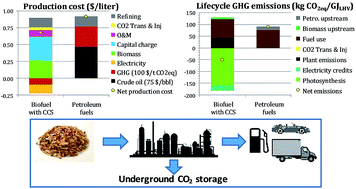Negative-carbon drop-in transport fuels produced via catalytic hydropyrolysis of woody biomass with CO2 capture and storage†
Abstract
Process designs for prospective first-of-a-kind (FOAK) catalytic hydropyrolysis facilities converting woody biomass residues into “drop-in” transportation fuels were developed, including some designs incorporating CO2 capture and storage (CCS). The energetic, carbon, and economic performances of these designs were simulated and analyzed. Estimated greenhouse gas emissions for the resulting fuels are far below those of conventional petroleum-derived fuels. For plant designs with CCS, the biofuels are characterized by strongly negative emissions. The additional capital costs and energy penalties for CO2 capture range from modest to high, depending on the extent of capture employed. The fuel production cost at a commercial-scale FOAK plant without CCS corresponds to a break-even crude oil price of 95 $ per bbl. At a 120 $ per t CO2,eq. greenhouse gas (GHG) emission price, the plant design that would capture about half of the CO2 available for capture would have identical production cost as the design without any CO2 capture; in both cases the break-even oil price would be 28 $ per bbl. A design maximizing CO2 capture would produce fuels with a break-even oil price of 44 $ per bbl at this GHG emission price. The prospective economics of drop-in fuels from biomass produced via catalytic hydropyrolysis appear quite favorable relative to other biofuel production systems, but can only be confirmed via demonstrations at scale.


 Please wait while we load your content...
Please wait while we load your content...